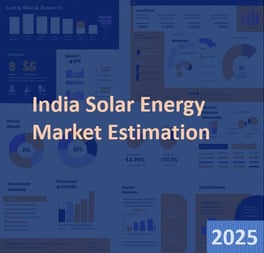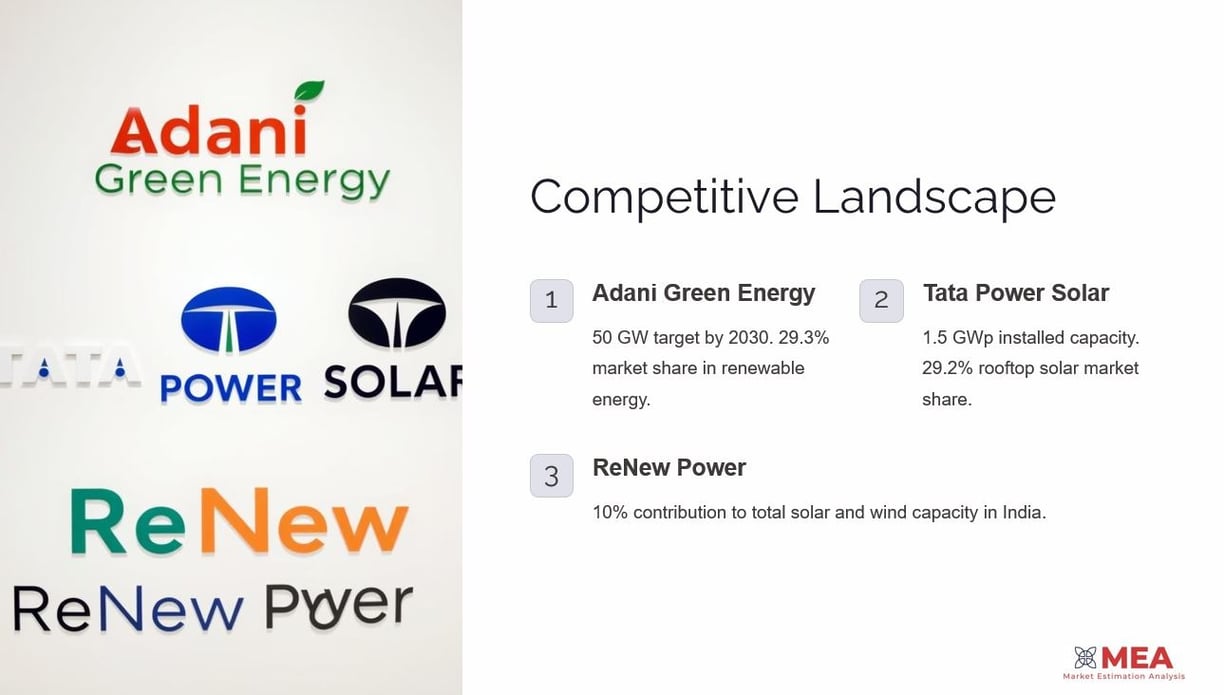

India Solar Energy Market (2025-2033)
Only Excel
The Excel covers estimation with respect to the India Solar Energy Forecast and is Segmented by Technology (Solar photovoltaic (PV), and Concentrated solar power (CSP)), and Application (Utility-scale (grid-connected), and Off-grid). For Each Segment, the Market Sizing and Forecasts have been done based on Revenue (USD Million).
Historical Year: 2021-2023 | Base Year: 2024 | Forecast Year: 2025-2033
Market Overview
Solar power is an essential component of India's renewable energy landscape. As of 2025, solar power contributes approximately 90 GW to India's energy mix, which is about 45% of the country's total renewable capacity. India had added 9.7 GW of solar PV capacity in 2023, ranking fifth globally for new installations with a cumulative capacity of 72.7 GW by the end of the year. The country is also positioning itself as a manufacturing destination for solar photovoltaic cells, supporting domestic production through Production Linked Incentive (PLI) Schemes. Solar energy offers a sustainable solution to India's energy needs, aligning with its goals for energy security and reduced greenhouse gas emissions. Solar power is a clean and environmentally friendly energy source that produces no greenhouse gas emissions. The expansion of the renewable energy sector, including solar, has also led to the creation of green jobs, with an estimated 1.02 million jobs in India's renewable energy sector in 2023.
As of January 31, 2025, India's total installed solar capacity reached 100.33 GW, with an additional 84.10 GW under implementation and 47.49 GW under tendering. The Indian government aims to achieve 500 GW of non-fossil fuel-based energy capacity by 2030, with a significant portion expected to come from solar. To meet these goals, the government is promoting various schemes and policies to boost solar energy adoption across the country.
Market Dynamics and Growth Prospects
India Solar Energy market size reached US$42.00 Billion in 2023. MEA (Market Estimation Analysis) expects the market to reach US$95.92 Billion by 2033, exhibiting a growth rate (CAGR) of 8.81% during 2025-2033.
India has set ambitious renewable energy targets, including reaching 500 GW of non-fossil energy capacity by 2030 and fulfilling 50% of its energy requirements through renewable sources by the same year. Solar power plays a crucial role in these goals, contributing approximately 90 GW, which is nearly 45% of India's total renewable capacity. Solar energy is environmentally friendly and has the potential to provide a sustainable solution to India's increasing energy demands. India is dedicated to growing its renewable energy sector, as evidenced by the country's total renewable energy capacity crossing 200 GW. In October 2024, the total renewable energy installed capacity reached 203.18 GW, marking a 13.5% increase from 178.98 GW in October 2023. Renewable energy sources now constitute over 46.3% of India's total capacity, with the nation aiming for 500 GW from non-fossil sources by 2030.
Key Market Trends Shaping the Industry
India's solar energy market is experiencing emerging trends and opportunities through floating solar projects, green hydrogen integration, solar-wind hybrid projects, and expansion of domestic solar manufacturing. These trends align with India's commitment to increasing renewable energy capacity and achieving its net-zero emissions target by 2070.
Floating Solar Projects: Floating solar projects are gaining traction in India, driven by land scarcity and the need to meet renewable energy targets. India has a floating solar potential of 207 GW to 300 GW. These projects involve mounting solar panels on floating structures in water bodies like lakes and reservoirs, offering benefits such as optimized land use and reduced water evaporation. Tata Power commissioned a 126 MW floating solar plant in Madhya Pradesh in 2024, and the government is seeking developers for floating solar projects at 35 dams and reservoirs.
Green Hydrogen Integration: The integration of green hydrogen with solar energy projects is an emerging trend in India's solar market. The National Green Hydrogen Mission aims for 5 MMT annual production by 2030, supported by 125 GW of renewable energy capacity. Green hydrogen, produced using renewable energy sources, can help decarbonize sectors like refineries and transportation, while also reducing reliance on fossil fuels. This initiative targets significant investments and clean energy growth, positioning India as a global hub for green hydrogen production.
Solar-Wind Hybrid Projects: India's renewable energy sector is witnessing growth in solar-wind hybrid projects, aiming for 9,500 MW capacity by 2025. These hybrid projects combine solar and wind power generation to provide a more stable and continuous power supply. India added 28 GW of solar and wind capacity in 2024, with solar comprising 70%. Solar-wind hybrid projects have garnered significant interest due to the growing demand for firm green power from both distribution companies and corporate consumers.
Expansion of Domestic Solar Manufacturing: India's solar manufacturing is rapidly expanding, with module production capacity at 58.4 GW and expected to reach 119 GW by 2030. Cell manufacturing is also increasing, projected to reach 61.6 GW by 2030. The government's "Make in India" initiative and Production-Linked Incentive (PLI) schemes are boosting domestic manufacturing and reducing reliance on imports. The country's solar cell manufacturing capacity is expected to reach 50-55 GW by FY27, a fivefold increase from 10 GW at the end of FY24.
Segmentation and Market Insights
MEA provides an estimation of each segment of the India Solar Energy market, along with forecasts at the country level from 2025-2033. Our excel has categorized the market based on technology, and application.
Segmentation by Technology: The solar photovoltaic (PV) segment is expected to dominate the Indian solar energy market due to decreasing costs and versatile applications. Monocrystalline modules currently account for a major share of India's total PV panel production. Thin-film solar technology is also significant, particularly with the expansion of First Solar's CdTe technology.
Segmentation by Application: The India solar PV market is divided by installation type into utility-scale, commercial, and residential. Utility-scale installations are currently the most dominant in India's solar PV market, bolstered by large-scale projects in regions like Rajasthan and Gujarat. Off-grid solar is expected to register the fastest CAGR during the forecast period, driven by private sector involvement and untapped potential in unrecorded localities.
Get Accurate Forecasts and Data
Our meticulously designed Excel sheet provides detailed forecasts and estimations for the India solar energy market. With segmentation across technology, and application, our data enables businesses to identify opportunities, analyze trends, and strategize effectively in this dynamic market.






SEGMENTS COVERED
By Technology
Solar photovoltaic (PV)
Concentrated solar power (CSP)
By Application
Utility-scale (grid-connected)
Off-grid
Scope of the Market Estimation
Detail
2021-2033
2024
2025-2033
Value (USD Million)
Technology, and Application
Metric
Market size available for years
Base Year Considered
Forecast period
Forecast units
Segments
Insights
Empowering businesses with data-driven market estimations.
© 2025. All rights reserved.
Links
Address
Jorhat, Assam, India
Post Office - 785015
Follow us
Registration Number: UDYAM-AS-15-0024368
We Accept
Opening hours
Monday - Friday: 10:00 IST- 19:00 IST
Saturday - Sunday: Closed
